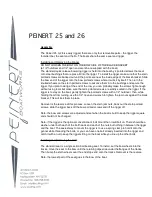
6
gine becoming unattached!
B16.
Don’t put your boat in contact with objects or matters which have a temperature lower than - 20°C or higher than + 60°C. It
may seriously damage the PVC material.
REFUELLING
C1.
WARNING:
Fuel is highly flammable.
- Maintain fuel in containers that are specially designed for that purpose.
- Refuel outside the craft only, before starting the engine. Do not smoke while refueling or handling fuel.
- Never remove the gas cap or refuel with the engine running or while it is still hot.
- Always stop the engine and turn off the ignition before refueling.
- Fuel tanks must be handled with care to avoid leakage in the boat or water.
- Do not start the engine if fuel has been spilled: move away from the area where the fuel has been spilled and be careful not
to create any sparks until the fuel has completely evaporated and the fumes have dissipated.
- Correctly close the fuel tank by tightening the caps.
- Always work during the daytime.
- If your craft is equipped with an electrical power supply, turn it off.
- When refueling, reduce the number of persons aboard to a minimum.
- Keep a fire extinguisher within reach.
- Refer to the engine manufacturer's recommendations to know which type of fuel touse.
- Never fill your fuel tank to the brim (leak hazard).
- Regularly inspect the fuel system connections to prevent possible fuel leaks.
NAVIGATION
D1.
Risk of carbon monoxide poisoning:
Exhaust gases contain carbon monoxide which is a toxic, colourless and odourless gas. Inhaling carbon monoxide can lead to
loss of consciousness and death. The concentration of exhaust gases in the air may increase considerably if the engine is
running in a confined or partially confined area. Ensure that adequate ventilation is provided to avoid the excessive accumula-
tion of exhaust gases.
D2.
All passengers must be seated inside the boat and must be able to hold onto one or two "handles". Do not sit on the tubes.
D3.
Incorrect operation of outboard engines can be dangerous and rough handling of your tender may lead to serious injury or
death. Never equip a boat with an engine for which it is not adapted. Stay clear of swimmers and do not allow them to ap-
proach the aft of the boat when the engine is running.
D4.
Avoid rapid acceleration which may cause you or your passengers to fall overboard.
D5.
If your inflatable tender must be towed, REMOVE all load. Passengers must not remain aboard.
D6.
Never tow your tender by the mooring ring at the front, use the towing rings on the side. If it is equipped with only a ring at
the front, haul it aboard.
D7.
The weight must be equally distributed. Do not accelerate suddenly if your boat is motorised and not heavily laden.
A poorly controlled boat may result in stability and maneuvering problems.
MAINTENANCE AND STORAGE
E1.
Refer to the manufacturer's instructions for the correct installation and use of accessories.
E2.
Never store a boat with fuel in the tank in a room where the fuel vapours may reach a flame, spark or a strong source of
heat.
E3.
Never use polishing or cleaning products containing alcohol to clean your watercraft. Doing so may lead to the premature
drying out of the tube material.
E4.
Some chemical reactions and serious damages may occur if the PVC tubes and floor of your boat come into contact with
some particular substances:
E5.
PVC is sensitive to UV (ultraviolet) radiation. If the boat must be stored outdoors, make sure it is protected with a suitable
cover (Honda cover available as an option).
Substance
Max. contact period
Substance
Max. contact period
Polystyrene
10 hours
Asphalt
15 minutes
ABS
10 hours
Mineral oil (pure)
3 minutes
Rigid PVC
10 hours
Water + Petrol
15 minutes
Bitumen
3 minutes
Carbon chloride
3 minutes







































